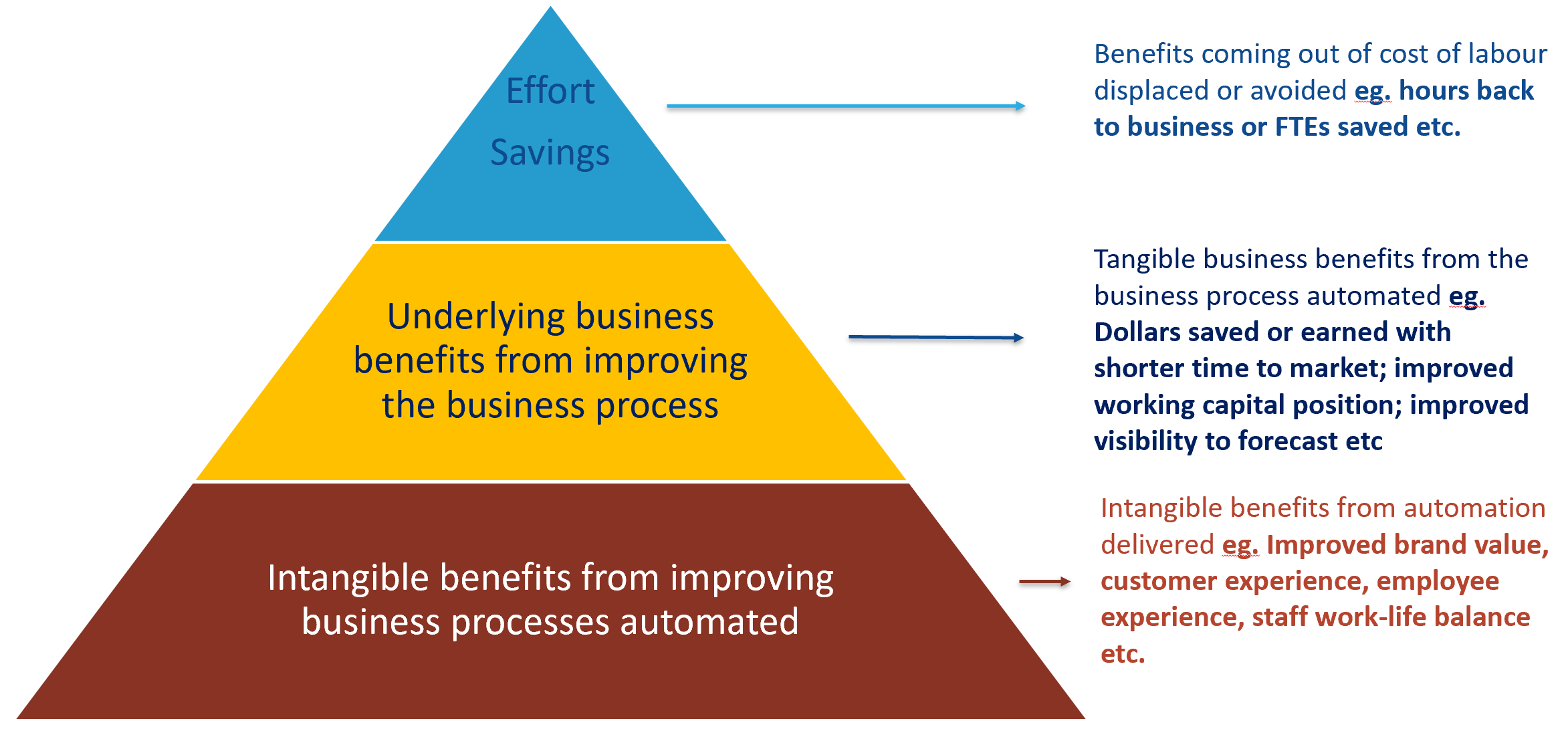One of the key things around Intelligent Automation (IA) is to ensure it has a strong business foundation not just in planning, execution and validation but also in assessing and reporting business benefits. While this may seem simple, it’s often not done well in most organizations and leads to a skewed view of business benefits from automating business processes.
Why Calculate Benefits from Process Automation?
It’s well understood that organizations looking to make substantial business impact through intelligent automation need to have the right criteria to review the pipeline to shortlist the best candidate processes. These criteria need to rate various functions based on the benefits they will bring to the organization after automation. This ensures that the limited resources to develop and run automation is directed toward opportunities that yield maximum business returns.
Second, there should be an essential step of capturing the benefits after a process is automated. It helps improve the process assessment criteria through a feedback mechanism.
Finally, presenting business benefits from process automation helps showcase to the larger organization the value already being delivered and helps drive the future pipeline.
Calculating Business Benefits from Process Automation
Once business value is determined from processes automation, how does one estimate this business value? Most organizations look at labor savings as that criteria. Some have it as the number of Full-Time Equivalents (FTEs), which is roughly translated as the number of human hours equivalent to a person’s productive time at work.
Many also factor in additional benefits like 24x7 operations with automation, increased speed of processing and zero/low errors, which is incorporated into the FTE numbers. Organizations further process FTE numbers with the cost of labor to find a dollar value. Hence, the list of processes being assessed is rated based on their “FTE Value” or equivalent “dollar value.”
This single dimension of estimating the value of the benefit from process automation in terms of FTE cannot be more flawed. This is similar to the models used in the outsourcing industry. Those make sense in the outsourcing world as the work moved from one set of humans to another with a different cost and ownership structure. The way the work is done does not change.
However, when work gets automated, it is moving from human workers to digital workers. Digital workers are not just doing the same job. They are also able do the same work much faster and with more accuracy and efficiency. The benefit of this is way beyond their labor-saving equivalent.
The benefit of these “terms of operations” when processes are automated have a much deeper impact on a business once we understand the impact of speed, accuracy and efficiency on the process being automated. The work is not just being done by digital workers, it’s also being done in a superior manner, and several other benefits are achieved depending on the nature of the process. These benefits bring much higher value to businesses than just those from labor savings.
To illustrate this, consider the following simplified example:
Before: In a large legal firm that mostly worked with corporate organizations, there was a team of 20 individuals working across three locations to prepare data for monthly billing. This involved processing customer engagement data, milestone completion, hours spent split across projects and locations, and different client corporate entities across different countries. Additionally, this involved going through other clauses in each contract every month to arrive at the final amount to be billed for each legal entity of the customer across multiple project invoices.
This work could only start at the end of each preceding month. With the scale of operations, it took time to go through the set of structured and semi-structured data. It normally takes this team around 10 to 12 days to process all this data and send the information to the billing team. So, while the billing could be contractually done on the first of every month for the preceding month, invoices would typically be dispatched by 12th of the month after all the data was reviewed, scrubbed and validated for getting the correct billable amount.
After: After automating the process, 90% of billing data across all customers was processed in three days. Some exceptions needed deeper human intervention and human validation, but now only required a team of four members instead of 20 members.
Benefits: With a traditional way of looking at this process automation, which helped re-deploy 16 members of the staff for other activities, the benefit from automating the process was 16 FTE. Assuming that work was being done from various offshore locations, this savings could be translated to around $300,000 per year without getting into the intricacies of chargebacks, etc., for the sake of this illustration. However, there were several other benefits the business achieved, and these were way beyond the labor savings of $300,000.
For starters, by reducing the time to process billing information from 12 days to three days for 95% of invoices, this organization was able to raise invoices nine days earlier. This roughly translated to $200,000 per month or $2.4 million per year with a very conservative estimate of cost of capital. Additionally, this benefit amount increased as business grew. The digital workers didn’t take additional time to process more billing data as linearly as their human counterparts.
This $2.4 million benefit back to the business is three times the relatively smaller cost of FTE savings earlier calculated at around $300,000. This dramatically improved their working capital position. Further, this improved their ability to forecast on several financial parameters which can further be quantified.
Beyond this, this automation also helped improve the work-life balance of their invoice preparation staff for which a dollar value is not easy to be defined. Staff was not required to work longer hours and this resulted in improved productivity and better employee engagement. In turn, this helped them attract and retain better talent.
Challenges in Calculating Business Benefits from Process Automation
Like with any enterprise transformation program, driving automation has its share of challenges when it comes to calculating business benefits.
- The wide range and type of processes makes it difficult to have a way to calculate benefits that are standard, and at the same time covering all aspects.
- The teams involved often don’t know these processes intimately or do not have the full business view of the process to be able to find the full impact of automating them
- Each business unit has a different way to calibrate existing processes therefore inputs vary and make it difficult to have a model that covers all of these
- Lack of business and commercial expertise in estimating these business benefits
The diagram below summarizes the pyramid of business benefits covering tangible and intangible benefits from automating business processes.

To Summarize
In summary, business benefits from automating processes go beyond FTEs and labor savings. The above diagram attempts to cover all these various benefits holistically, but here are the main takeaways:
- The FTE savings on the top of the pyramid are most visible but is the smallest component
- Often a larger chunk of savings is returned with positive impact on the process being executed at a much higher speed, with no errors and a standardized approach
- Finally, the greatest value (bottom of the pyramid) is the most understated and underestimated. These are related, extremely valuable yet intangible elements like customer experience, employee experience, staff work-life balance, brand value, etc.
(The views expressed here are author’s personal views and not attributable to the any employer.)









